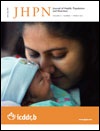Implementing HIV/AIDS Education: Impact of Teachers Training on HIV/AIDS Education in Bangladesh
DOI:
https://doi.org/10.3329/jhpn.v31i1.14745Keywords:
Course curriculum, Health education, HIV and AIDS, Teachers training, Youth, BangladeshAbstract
School-based HIV/AIDS education is a common and well-proven intervention strategy for providing information on HIV/AIDS to young people. However, lack of skills among teachers for imparting sensitive information to students can lead to programme failure in terms of achieving goals. A cross-sectional study was conducted among teachers to identify the factors that support or hinder their role in HIV/AIDS education. A self-administered questionnaire was used for interviewing teachers from randomly-selected schools in two adjacent districts in Bangladesh. Based on exposure to teachers training, the districts were divided into control and intervention areas and the teachers ability, skill, and their participation in HIV/AIDS education were compared between the districts. Trained teachers in the intervention schools were more likely to participate, less likely to face difficulties, and more likely to use interactive teaching methods in HIV/ AIDS classes compared to the controls who did not receive any training. Inadequate allocation of time for conducting the HIV/AIDS class was found to be barriers to HIV/AIDS education that suggest the need to provide teachers with more support in terms of training and logistics.
J HEALTH POPUL NUTR 2013 Mar;31(1):20-27
DOI: http://dx.doi.org/10.3329/jhpn.v31i1.14745Downloads
452
303

